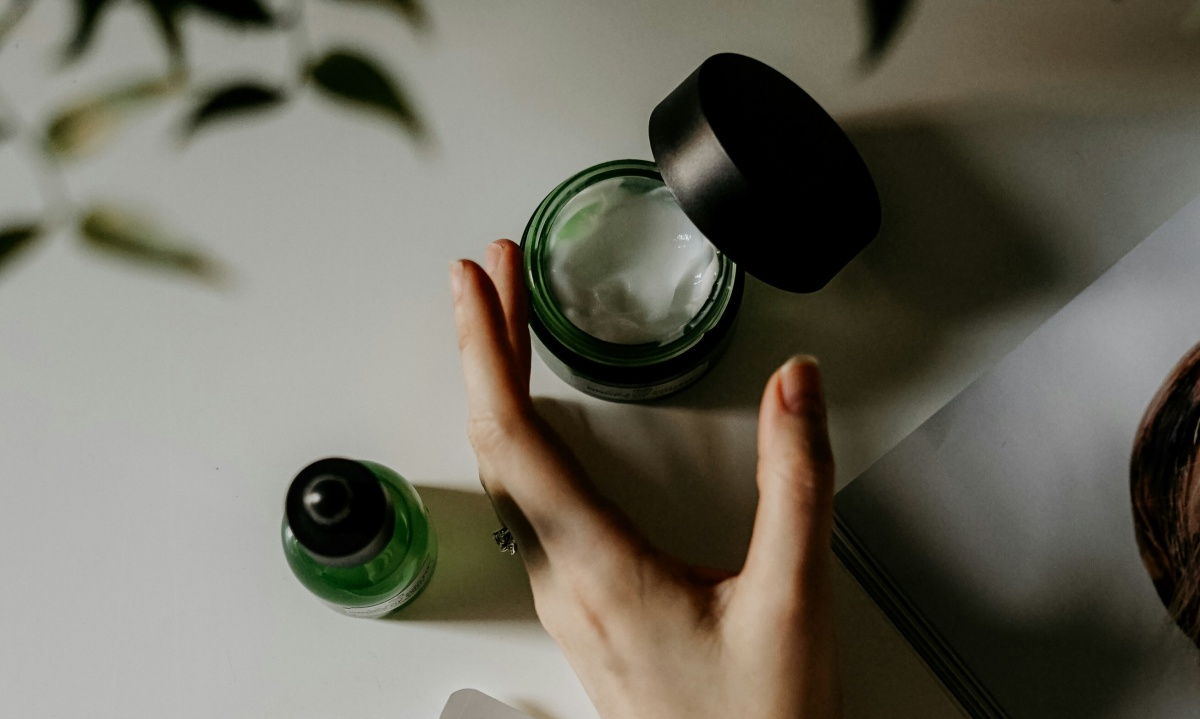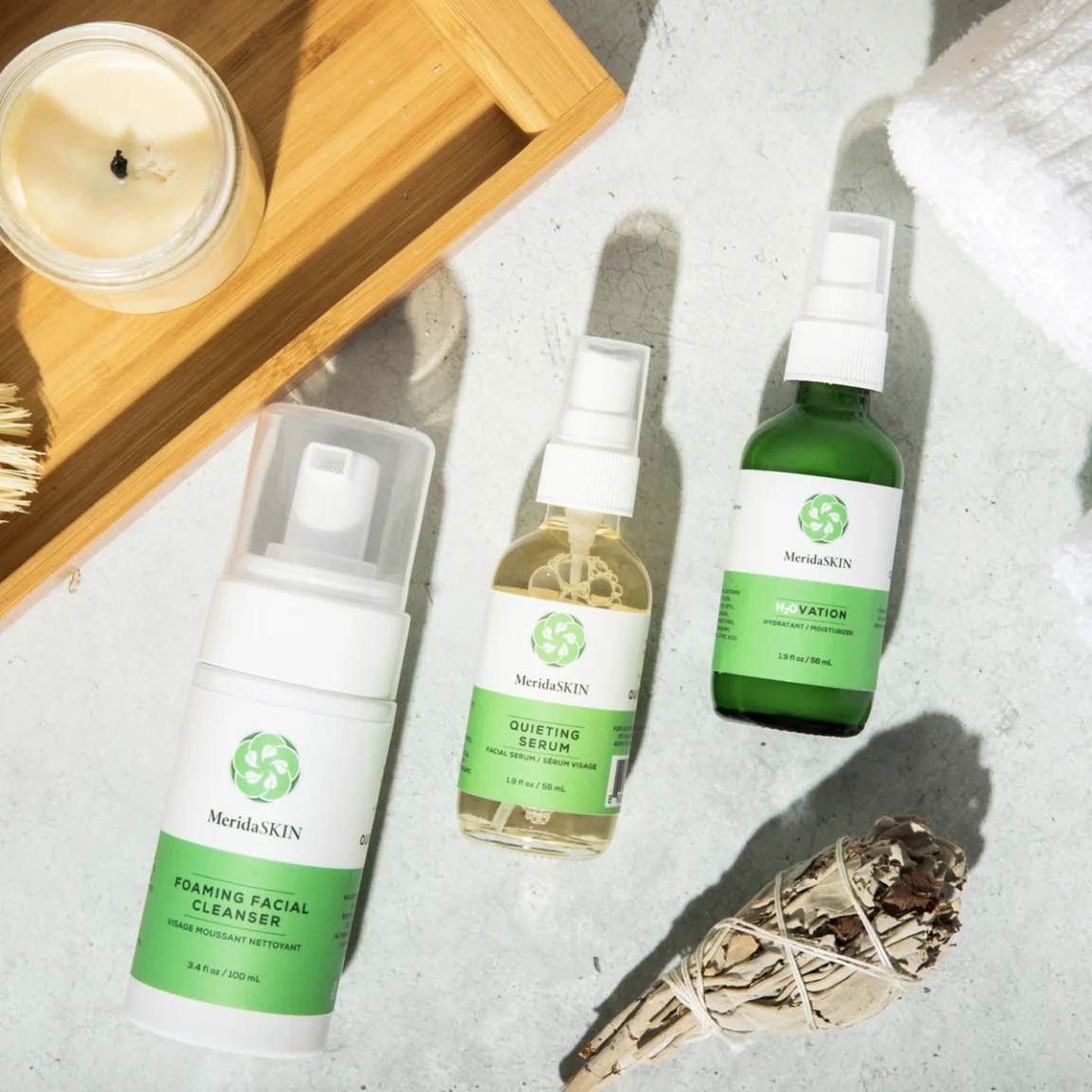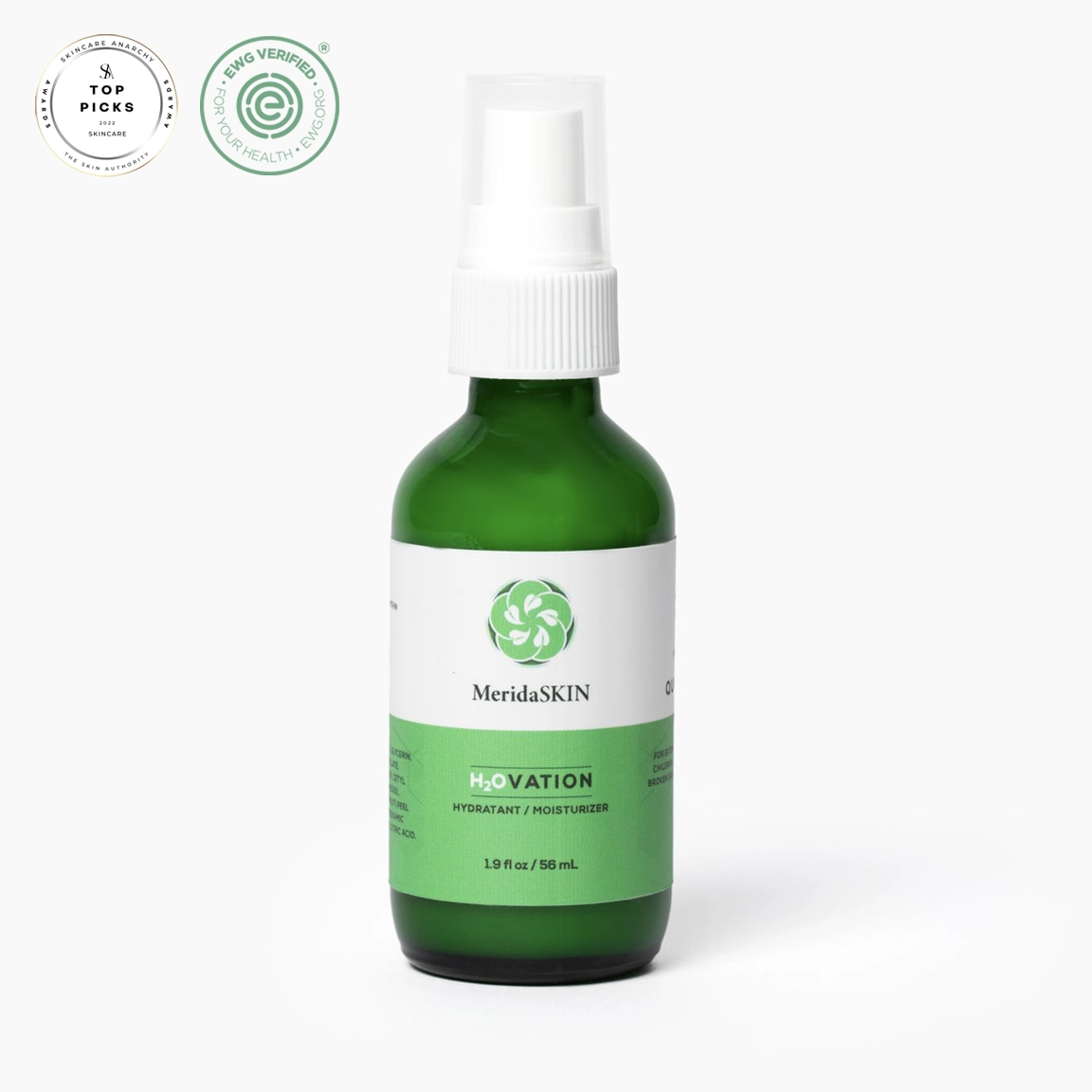If you want to reduce skin redness, it may seem as though you have a lot of options. With so many products on the market, how do you choose the best option? More importantly, how do you do it naturally, without adding more products, toxins and chemicals to your skincare routine?
Here are a few steps you can take to start reducing redness and supporting your skin’s long-term health.
-
Merida Essentials: Skincare for Sensitive Skin
$108.00 -
Shea and Squalane Moisturizer for Sensitive Skin
$45.00 — or subscribe and save up to 12% -
Tea Tree Oil Foaming Facial Cleanser
$23.00 — or subscribe and save up to 12%
1. Identify the Cause of Your Skin Redness
Remove the aggressors. The most satisfying long-term solution unquestionably requires identifying and eliminating the root causes of the redness as much as possible. This takes close observation and a bit of patience, but usually pays dividends.
For lots of people, redness comes from several, or even many, things adding up, rather than one single thing. Durable relief involves systematically deleting those things.
Redness can be triggered or aggravated by factors such as:
- Foods
- Beverages (especially alcohol and hot beverages)
- Weather and temperature (such as sun, strong wind, extreme hot, cold and humidity)
- Emotional influences (such as stress and anxiety)
- Physical exertion
- Medications (such as vasodilators and topical treatments)
- Medical conditions (such as menopause and caffeine withdrawal)
- Skincare products
The National Rosacea Society published the results of their Rosacea Triggers Survey, showing the percent of rosacea patients affected for 20 factors (spoiler: sun exposure topped the list, with 81% of rosacea patients identifying it as a trigger for their redness).
Keeping a diary of exposures and symptoms for at least 2 weeks is the recommended way to identify redness culprits. This doesn’t need to be an all-consuming task. Simply set aside a couple of minutes at the end of each day to jot down what happened in the previous 24 hours.
The National Rosacea Society provides a free printer-friendly Rosacea Diary, which can also be used for other redness conditions.
2. Use Gentle, Fragrance-Free Skincare Products
In the National Rosacea Society Triggers Survey, 41% of rosacea patients implicated skincare products as a trigger for their symptoms. This makes sense because irritating, allergenic and pore-clogging ingredients are incredibly common in skincare products, even the ones marketed as gentle and suitable for sensitive skin.
Unfortunately, label claims of gentle, sensitive, hypoallergenic, non-comedogenic, and the like, don’t require proof, so staying clear of problem formulas requires more vigilance.
Seals such as the Seal of Acceptance from the National Rosacea Society or the Seal of Approval for Eczema will mean that a panel of dermatologists reviewed and approved the safety testing performed in individuals with sensitive skin.
Not all brands pay to get those types of seals, so if you want a bigger universe of products to consider, then another option is to get savvy about scrutinizing the list of ingredients. Apps such as Think Dirty® and online resources such as the Environmental Working Group (EWG) Skin Deep® Cosmetics Database can be helpful in checking product and ingredient risk.
Here are some best practices to help you avoid skin reactions and purchase-regret:
- Steer clear of products with a long ingredient list. More ingredients means more chances of a problem.
- Avoid ingredients that end in the word “sulfate” or choose products that say “sulfate-free.” The “sulfates” such as sodium laureth sulfate and sodium lauryl sulfate have a relatively high potential for causing skin irritation.
- Go fragrance-free. If the list of ingredients contains “fragrance” or “parfum” you can’t know what those are, and they are a common source of skin reactions.
- Avoid menthol, eucalyptus, witch hazel, and non-fatty alcohols (such as benzyl alcohol and alcohol denat.). These are common redness triggers.
- Shop paraben-free. The paraben preservatives (such as methylparaben and propylparaben) are known for causing allergic skin reactions.
- For leave-on products (such as moisturizers and sun protectants), be sure none of the ingredients end in the word “glucoside.” The alkyl glucosides (such as coco glucoside and decyl glucoside) often cause allergic skin reactions in products that remain in contact with the skin for more than a few minutes.
3. Incorporate Calming and Soothing Ingredients
Add things that help. Because the carrier vehicle (cream, gel or ointment) for topical prescriptions can include problematic ingredients, it may be preferable to settle on a beneficial skincare routine before deciding whether to proceed with prescription medication.
The use of plants as medicine long precedes the modern-day pharmaceutical mega-industry. Set fad ingredients aside, and focus on botanicals that are well-studied and have good evidence behind them in the fight against facial redness.
Some of the most interesting are categorized as adaptogens. Adaptogens are natural substances found in plants and mushrooms that help the body cope with stress and aid in returning the body to a state of balance. Adaptogens must be non-toxic in normal doses. Adaptogens of interest for skin application include:
- Aloe vera (Aloe barbadensis)
- Ashwagandha (Withania somnifera)
- Ginseng (Panax ginseng)
- Gotu Kola (Centella asiatica)
- Holy Basil (Ocimum sanctum)
- Turmeric (Curcuma longa).
This list is not exhaustive, but it is a good starting point.
These ingredients can be incorporated anywhere in the skincare routine, but will do the most good in leave-on products such as serums and moisturizers. Masks are a reasonable vehicle as well, provided you don’t cleanse soon after. It is important to consider that the beneficial effect of these substances depends greatly on how they are harvested, processed and delivered to the skin.
Without proper safeguards, contaminants or co-ingredients could cancel the positive effect or even introduce more risk. For this reason, it is important to buy only from trusted sources, and preferably those that have a third-party verifying the safety of their ingredients.
4. Hydrate Your Skin with Moisturizers and Humectants
A healthy skin barrier is absolutely essential in the fight against facial redness and discomfort. Imagine your skin cells as bricks. If a lot of mortar around the bricks is missing, more water can be lost, and more bad stuff can get in.
This is one place where adding certain things can help. The goal of moisturizing agents is to fill in the spaces around the bricks and seal the surface. A nice tight barrier keeps water and other good stuff in, and toxins and pathogens out.
This can be accomplished with a combination of humectants, which attract and bind water, and emollients, which form a film (they also smooth and soften the skin). Some ingredients can perform both roles. Popular humectants include aloe vera, glycerin, honey, hyaluronic acid, and niacinamide. Popular emollients include aloe vera, glycerin, jojoba oil, shea butter and squalane.
For maximum benefit, apply a moisturizer that contains humectant(s) and emollient(s) within 5 minutes after cleansing, and preferably before the skin is completely dry.
5. Protect Your Skin from Environmental Stressors
Environmental stressors can take a big toll on skin health and aging. Sources of environmental stress include sun exposure, extremes of temperature and humidity, and pollution.
Sun exposure topped the list of triggers in the National Rosacea Society Rosacea Triggers Survey, cited as a trigger by 81% of surveyed rosacea sufferers. Sunlight also drives the vast majority of skin aging.
The best way to avoid sun exposure is to stay in the shade. The second best way is to cover up with a broad-brimmed hat, UPF-rated eye protection, and UPF-rated clothing. If exposing skin to the sun is a must, then mineral sunscreen offers the best protection with the least chance of causing an unpleasant reaction.
Zinc oxide and titanium dioxide are the only two active sunscreen ingredients that are classified by the US Food and Drug Administration (U.S. FDA) as Generally Regarded as Safe and Effective (GRASE). Both are mineral ingredients that reflect the sun’s rays. A host of chemical UV filters are permitted as active sunscreen ingredients in the US, but they come with two main problems:
- They absorb the sun’s rays and cause heating – which can trigger or aggravate redness.
- They have less favorable safety data as compared with the mineral UV blockers.
Pollution can penetrate skin cells and compromise the skin barrier, causing irritation and inflammation. To protect skin from pollution, cleanse once or twice a day to remove dirt and pollution, and follow that with a moisturizer to add hydration, seal gaps in the barrier, and create a film that prevents pollution from making in-roads.
Mineral sun protectant goes on top of the moisturizer, and adds another layer of defense against pollution.
6. Try Natural Remedies and DIY Masks
While not thoroughly studied in the medical literature, DIY homemade face masks can be an easy and satisfying way to soothe and pamper unwanted skin redness. Bonus: you get complete control over the ingredients. Popular ingredients to blend include:
- Avocado
- Honey
- Green tea
- Oatmeal
- Yogurt
Of course, avoid any of these if you suspect an allergy. Manuka honey holds a special place among the honeys because it contains methylglyoxal (MGO), which imparts extra anti-bacterial power. However, Manuka is a raw honey that may contain traces of bee venom, so is better avoided by people allergic to bee stings.
Some ingredients should be off the list for folks with facial redness or irritation. These include:
- Lemon and apple cider vinegar, because they are very acidic
- Cinnamon because it can trigger allergy.
- Turmeric has been popular in recent years, but be warned that it can cause skin discoloration.
Whatever you decide to create, make a small amount to patch test before committing to a full application. Put a dime or nickel-sized amount behind one ear, leave on for 15 minutes, cleanse off, and wait 24 hours to see if any reaction occurs. If you settle on a recipe you love, always use what you make immediately, though you might want to refrigerate briefly so it doubles as a cool compress.
7. Maintain a Healthy Lifestyle to Support Skin Health
Lifestyle habits have a big role to play in skin health and appearance. Most people understand that adequate hydration is essential for happy skin, but beyond that, there is a growing understanding of the gut-skin connection and the brain-skin axis.
It is now clear that the gut is far more complex than once thought, and has wide-ranging effects on overall health. So, if you want to be good to your skin, be thoughtful about how you nourish your gut and its very important community of micro-organisms (microbiome).
Avoid foods associated with inflammation (such as highly processed foods, red meat and some dairy), and emphasize those with anti-inflammatory and anti-oxidant potential (such as berries, tart cherries, leafy greens, avocado, fatty fish, and nuts such as walnuts and almonds).
On a related note, be cautious about ingesting things that disrupt the balance of the gut microbiome, including limiting oral antibiotic use to absolutely essential instances where nothing else will do the job.
The brain-skin axis refers to the complex communication that goes back and forth between the brain and the skin. Yes, that really happens. The brain and skin influence each other through signaling chemicals.
For example, stress can lead to the release of cortisol, which can affect skin inflammation, and the immune system in the skin can trigger the release of cytokines, which circulate to the brain, affecting mood and behavior. The big takeaway: stress management matters for skin health, and skin health matters for mental health.
Reducing Skin Redness Naturally IS Possible
The most satisfying result is often won with a bit of patience and effort. Tackling facial redness is no exception. For many people, the redness arises not from a single cause, but rather several or even many things adding up to the storm.
It can take close observation and systematic trial to solve, but that approach can land in a better place than throwing a revolving door of medications and over-hyped products at the issue. Identifying triggers and removing aggressors and risky exposures is a good place to start. This may involve transition to a simple skincare routine with a small number of carefully chosen ingredients. Keep a diary for at least 2 weeks, and try not to introduce or change more than one thing every few days so it will be easier to identify the culprit if an issue arises.
As you go, remember to practice kindness to self, and make stress relief a priority in every day.

Shannon L. Johnson NP-C
Founder & Formulator, MeridaSKIN
Shannon is a nurse practitioner, and much of her career has served vulnerable populations at a community health center. She holds degrees from the University of Pennsylvania and Simmons University, and completed post-graduate training at the University of Massachusetts Boston. She tackled the science of cosmetic formulating to solve her own skin struggle with rosacea. Shannon was born in Oregon, raised in Eastern Massachusetts and has passionate ties to the Pacific Northwest, New England, and the mid-Atlantic. She lives on Boston's North Shore with her husband, two kids and mischievous Wheaten Terrier. She and her family pass the seasons by playing in water (liquid and solid).





Recent Comments